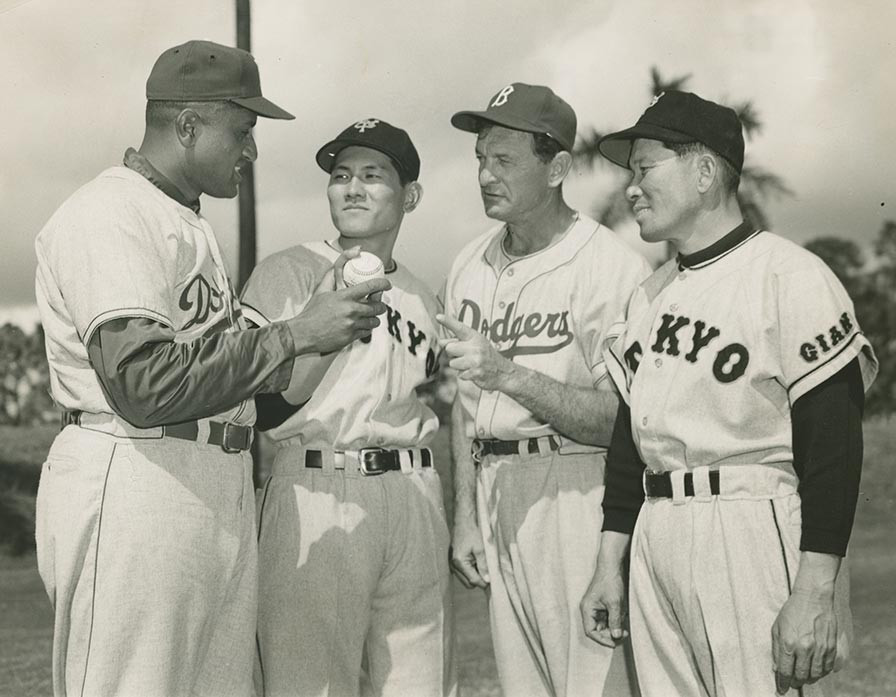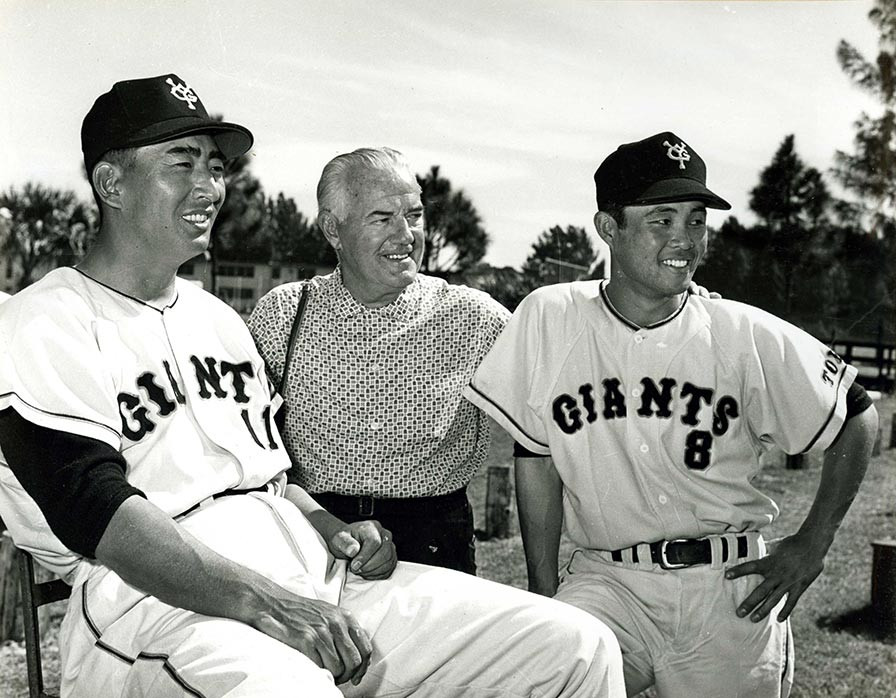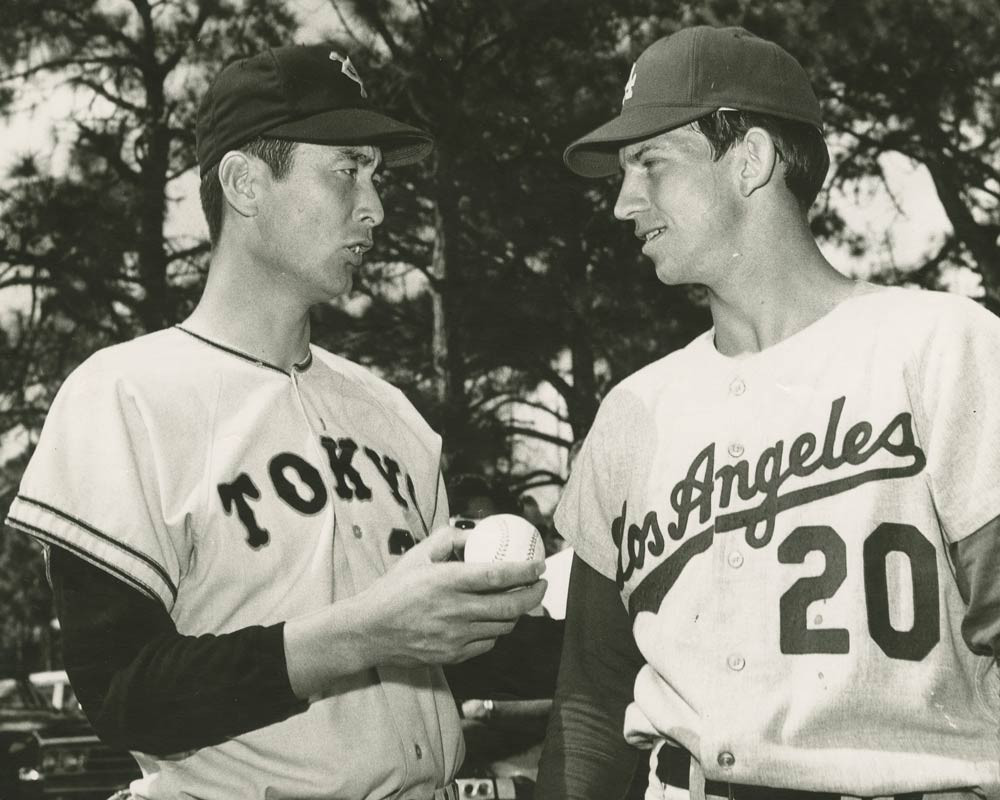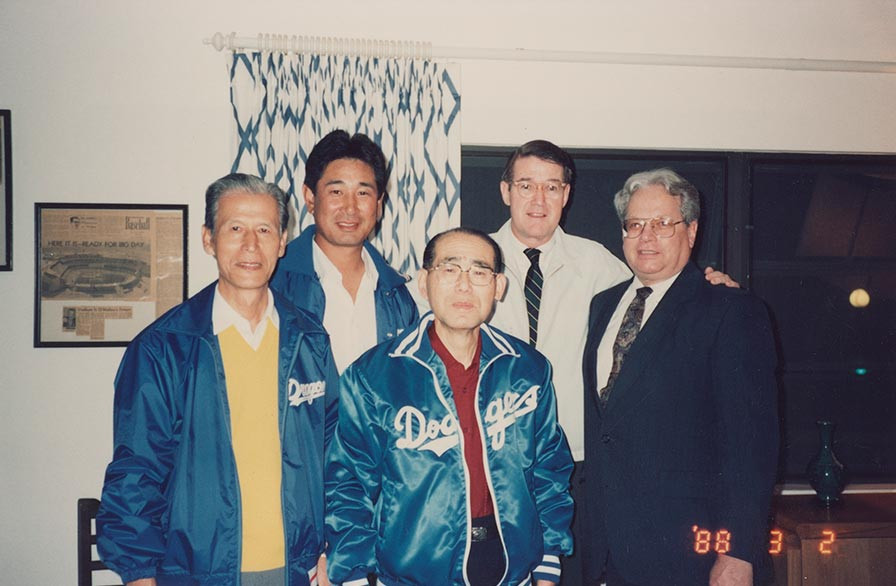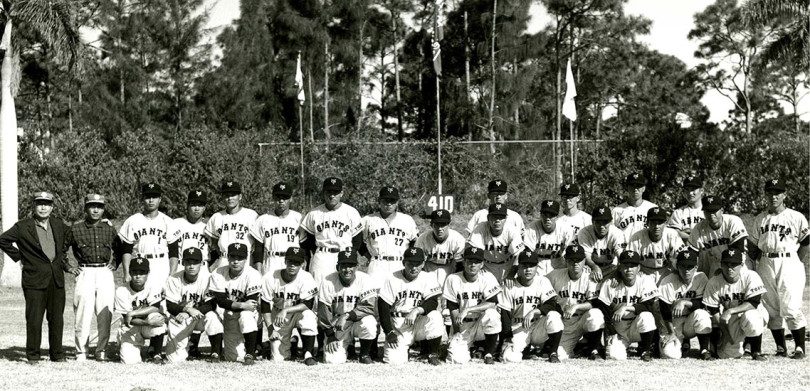
The 1961 Tokyo Giants pose for their team photo during their pre-season training workouts in Dodgertown, Vero Beach, Florida. The Giants had been invited to Dodgertown by Walter O’Malley and would later win the 1961 Japan Series that fall. They were led by Manager Tetsuharu Kawakami, who was inducted into the Japan Baseball Hall of Fame in 1965.
Feature
Japan and Dodgertown
Early in 1956, the Dodgers were invited by Matsutaro Shoriki, the founder of the Tokyo Yomiuri Giants and the “father of professional baseball in Japan,” to make a trip to Japan following the regular season. Shoriki also owned the widely-circulated Yomiuri Shimbun and founded Nippon Television Network Corporation.
It was Dodger President Walter O’Malley’s desire to accept the invitation and have the Dodgers make the goodwill tour in the fall to further international relations. He spent considerable time planning to ensure the key players would make the trip before responding. The Dodgers were at the height of their popularity, having won their first World Series Championship in 1955. Shoriki dispatched confidant and renowned Yomiuri sports columnist Sotaro Suzuki to New York to meet with O’Malley and personally act as his representative to make all necessary arrangements for the Dodgers to make the goodwill tour, sponsored by the Yomiuri Shimbun.
The plans for the 1956 Dodger Goodwill Tour of Japan were announced publicly by O’Malley on September 9. John M. Allison, U.S. Ambassador to Japan, issued a statement just before the Dodgers arrived in Japan. U.S. President Dwight D. Eisenhower authorized Allison to say that baseball has become “a regular and significant event in Japan’s relations with the United States.” Allison added, “This visit to Japan by one of America’s most notable baseball teams is an outstanding example of the many mutual interests shared by the people of Japan and the United States, the two nations which regard baseball as a national sport. It is but one of the many exchanges by which the two countries further their good relations and understanding.”
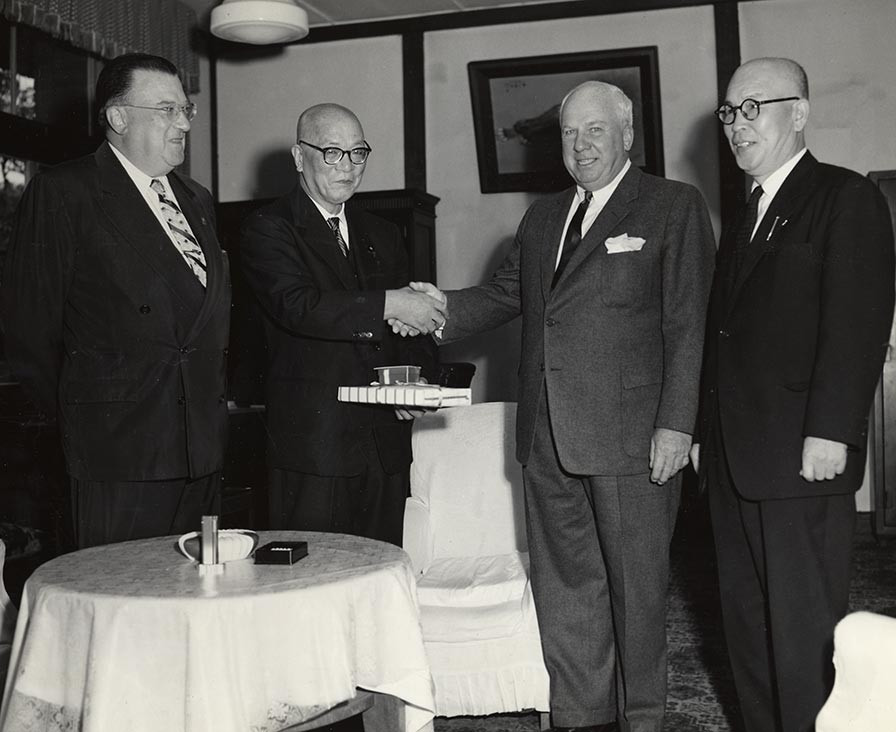
(L-R): Dodger President Walter O’Malley; Tokyo Yomiuri Giants owner Matsutaro Shoriki; National League President Warren Giles; and renowned Yomiuri sports columnist Sotaro Suzuki exchange gifts during the 1956 Dodgers Goodwill Tour to Japan. The tour was sponsored by Yomiuri Shimbun newspaper.
It was the first of three tours (1956, 1966 and 1993) to Japan arranged for by the O’Malley family. The first tour was so well-received by the people of Japan – some 450,000 fans attended Dodger games – it was no surprise that the friendly relationship continued to grow rapidly.
Dodgertown, Vero Beach, Florida has been at the centerpiece of the cultural exchanges, as O’Malley immediately invited Yomiuri Giants Manager Shigeru Mizuhara and two players, as well as Suzuki, to training camp in February and March, 1957. The entire Yomiuri Giants team visited Dodgertown for training camp on five occasions (1961, 1967, 1971, 1975 and 1981). The Giants won the Japan Series in four of those five seasons.
Through the years, the Dodgers have conducted numerous exchanges both in Japan and in the United States involving players, coaches, medical personnel, scouts and executives.
In June and July 2013, the Baseball Hall of Fame and Museum in Tokyo, Japan displayed 14 significant artifacts from the O’Malley’s and added more objects from their own collection in the exhibit: “Baseball in Japan and the O’Malley Family: A Lasting Friendship”.
The following details important dates in the Japan and Historic Dodgertown – Vero Beach, Florida relationship:
Japan and Historic Dodgertown – Vero Beach, Florida
October – November, 1956
Walter O’Malley arranges for the National League Champion Dodgers to make a post-World Series Goodwill Tour to Japan. Tokyo Yomiuri Giants owner Matsutaro Shoriki, the “father of professional baseball in Japan” sent Sotaro Suzuki, who was a famous sports columnist in Japan and a close confidant, to meet with O’Malley in the summer of 1956 and invite the Dodgers to travel to Japan. The invitation resulted in the trip that fall. The Dodgers complete the trip with a 14-4-1 record. Dodger future Hall of Famers on the trip include Jackie Robinson, Pee Wee Reese, Roy Campanella, Gil Hodges, Duke Snider, Don Drysdale, Manager Walter Alston, Coach Billy Herman, broadcaster Vin Scully and owner Walter O’Malley. Also, well-respected Major League umpire Jocko Conlan worked games on the tour. He was inducted into the Baseball Hall of Fame in 1974. On November 1, 1956, the Dodgers play at Hiroshima Stadium and dedicate a bronze plaque at the entrance to the stadium which states, “We dedicate this visit in memory of those baseball fans and others who here died by atomic action on August 6, 1945. May their souls rest in peace and with God’s help and man’s resolution peace will prevail forever, amen.”
February 28, 1957
Yomiuri Giants Manager Shigeru Mizuhara and two players are guests of O’Malley at Dodgertown in Vero Beach, Florida. Batterymates Sho Horiuchi, a right-handed pitcher, and Shigeru Fujio, a catcher, train alongside the Dodgers during Spring Training. Renowned sports columnist Sotaro Suzuki, continuing the friendly relationship established in 1956 during the Dodgers’ Goodwill Tour to Japan, also visited Dodgertown. Matsutaro Shoriki sends a March 26 telegram to O’Malley after their visit, “Mizuhara, Horiuchi, Fujio returned safely…deeply grateful for your unselfish kindness extended them. Boys report greatly profited from participating (in) your training camp.”
Spring Training, 1960
Kaoru Betto, the Japan Series MVP in 1950 for the professional Tokyo Daimai Orions, visits Dodgertown, Vero Beach, Florida to observe training techniques of the Dodgers. He remains with the Dodgers throughout the season at the request of Masaichi Nagata, owner of the Orions of the Japan’s Pacific League. In 1988, Betto, who managed four teams in Japan’s professional leagues for 20 years, was inducted into the Japan Baseball Hall of Fame.
Spring Training, 1961
The Tokyo Yomiuri Giants entire team makes its first visit to Dodgertown, Vero Beach, Florida for Spring Training instruction. The Giants arrived on the Dodger-owned DC-6B airplane on its maiden flight from Los Angeles. The Giants were led by Manager Tetsuharu Kawakami, while Walter Alston managed the Dodgers. Both men were later inducted into their respective country’s Baseball Hall of Fame. It was the first visit to Dodgertown by Yomiuri greats Sadaharu Oh and Shigeo Nagashima. The Giants won the Japan Series in the fall of 1961. In his first full-time spring job at Dodgertown, future Dodger President Peter O’Malley was responsible for the Giants’ schedule from their arrival to departure.
November 1, 1961
Walter O’Malley receives the following telegram from Matsutaro Shoriki, owner of the Yomiuri Giants, on the occasion of the Japan World Series victory over the Nankai Hawks, four games to two: “Thanks to you, Yomiuri Giants captured Japan Series bringing into full play what they learned at Dodgertown. Regards to all.”
1965
Akihiro “Ike” Ikuhara, a recent graduate of Waseda University in Japan, is hired by Walter O’Malley to learn all facets of the business side of baseball. Initially, Ikuhara assists Peter O’Malley at the Dodgers’ Triple-A team in Spokane, Washington. In 1982, Ikuhara was named Assistant to Dodger President Peter O’Malley, serving as a liaison for the Dodgers in numerous international exchanges and trips. Ikuhara, who passed away in 1992, was posthumously inducted into the Japan Baseball Hall of Fame in 2002 for his significant contributions to the growth of international baseball and friendly relations with Japan and many other countries.
March 1965
Sports columnist Sotaro Suzuki is invited to Dodgertown in Vero Beach, Florida. Suzuki was a close confidant of Matsutaro Shoriki, owner of the Yomiuri Shimbun, and was subsequently inducted into the Japan Baseball Hall of Fame.
Spring, 1966
Shigeru Makino, Hiroshi Nakao, Toru Shoriki (owner) and Roy Saeki (general manager) of the Yomiuri Giants and Yasuhiro Fukami, of Fukuoka Lions, visit Dodgertown in Vero Beach, Florida.
October-November, 1966
The National League Champion Dodgers travel to Japan for their second Goodwill Tour in the past decade. The trip is sponsored by the Yomiuri Shimbun. The Dodgers are 9-8-1 on the trip.
Spring Training, 1967
The Tokyo Yomiuri Giants train for the second time at Dodgertown in Vero Beach, Florida. The Dodgers and Giants played a “goodwill” game at Holman Stadium. Baseball Commissioner William Eckert threw the ceremonial first pitch and the Dodgers defeated the Giants, 5-3. The U.S. and Japan flags were posted in center field. Both teams were introduced to the crowd and as each Yomiuri player was presented he would take a few steps, bow in respect, as the fans responded with great applause. Twenty-one members of the Japanese media accompany the Giants. Masaichi Nagata (owner of the Orions) also visits Dodgertown. Giants’ owner and the “Father of Baseball in Japan” Matsutaro Shoriki writes a letter to Walter O’Malley at the conclusion of their visit, “I wish to express to you my profound appreciation and thanks for the warm welcome and generous hospitality you and your staff extended to Toru (Shoriki) and our players during their spring training in Vero Beach. It is no exaggeration to say that without what you and your people did for them it would not have been possible for them to see and learn so much of the American baseball in such a short period…I am sure we will have more occasions in future to work together in order to strengthen the close and friendly ties which already exist between our two teams.” Seven members of the Giants roster and coaching staff were either in or later inducted into the Japan Baseball Hall of Fame, plus Hall of Fame sports columnist and trip coordinator Sotaro Suzuki.
March, 1968
Yoshio Kitagawa, pitching coach of Giants’ farmhands, brings right-handed pitchers Tsuneo Horiuchi and Toshiharu Usami to Dodgertown in Vero Beach, Florida. Both players appear in Dodger exhibitions. Forty years later, with 203 wins to his credit, Horiuchi was inducted into the Japan Baseball Hall of Fame. Hiroshi Tsuchiya, retired from the Chunichi Dragons, spent the whole spring at Dodgertown.
Spring Training, 1969
Katsumi Shiraishi, coach of the Yomiuri Giants, Makoto Kurata, Shinichi Yamauchi and Hisao Niura, train at Dodgertown in Vero Beach, Florida. Fumio Hayashi and Noboru Aota (both of Hochi press) and Satoru Sugiyama (Chunichi Press) observe the camp at Dodgertown and the opening game of the regular season.
Spring Training, 1971
The Yomiuri Giants return to Dodgertown in Vero Beach, Florida to train. It is the third training camp at Dodgertown. Sadayuki Tokutake, a retired bonus player with the Yakult Swallows who later finished his playing career for Chunichi, observed the Dodger camp and stayed the entire summer in Los Angeles for further study. Tokutake also attended the All-Star Game in Detroit, along with Masanori Ochi, the writer and outstanding play-by-play broadcaster and color commentator for Nippon Television Network in Japan.
Spring Training, 1975
The Yomiuri Giants train at Dodgertown in Vero Beach, Florida from March 2-15, their fourth visit. It is the first camp under the supervision of new Manager Shigeo Nagashima. He succeeded successful manager Tetsuharu Kawakami, who retired after a second-place finish in 1974.
Spring Training, 1979
As guests of Peter O’Malley, Roy Saiki, General Manager of the Tokyo Yomiuri Giants, visits Dodgertown, Vero Beach, Florida, while Shigeru Makino, former infielder for the professional Chunichi Dragons from 1952-59 and Giants’ coach, observes Dodger spring training camp. Makino was inducted into the Japan Baseball Hall of Fame in 1991.
March 9-25, 1980
Representatives of the Yomiuri Giants Toshimitsu Suetsugu, minor league batting coach; Nobuyoshi Suzuki, minor league infielder; Yasuhiro Hayashi, rookie pitcher (top draft selection in 1979); and Akihiro Yamazaki, rookie catcher (second draft selection in 1979) visited Dodgertown in Vero Beach, Florida for training.
Spring Training, 1981
The Yomiuri Giants train at Dodgertown in Vero Beach, Florida for their fifth time. The Dodgers would go on to win the 1981 World Series Championship, while the Giants won the 1981 Japan Series.
1987
The Chunichi Dragons of Japan send two rookies to play for the Sarasota Dodgers (Takeshi Yamasaki and Tetsuo Arakawa) before the entire team trains at Dodgertown the next spring.
Spring Training, 1988
The Chunichi Dragons of Japan train for two and a half weeks at Dodgertown in Vero Beach, Florida. It is their first time training at Dodgertown. Five players remain in the Dodger minor league system during the 1988 season. On March 2, 1988, Miichiro Katoh, owner of the Dragons and chairman of the board of Chunichi Shimbun arrived at Dodgertown and was welcomed by Dodger President Peter O’Malley with a Dodgers jacket. Katoh attended the Dodgers – Dragons game on March 3. Dragons Manager Senichi Hoshino requested through O’Malley that left-handed pitcher Masahiro Yamamoto stay with the Vero Beach Dodgers for training under watchful eye of Akihiro “Ike” Ikuhara, assistant to O’Malley. O’Malley gladly approved and Ike took a discouraged Masa, on the verge of being released, under his wing. Ikuhara told Yamamoto, “Never give up. If you do, that’s the end.” After encouraging him and working with Yamamoto on his mechanics and an additional pitch – the screwball – Ikuhara was delighted to see him pitch well going 13-7 for Single-A Vero Beach. Upon his return to Japan, he went 5-0 and helped the Dragons to the 1988 Central League championship. Yamamoto would have even greater success, as he completed a stellar 27 seasons with Chunichi with 218 wins and a 3.44 ERA. In 2008, as a tribute to Ikuhara who passed away in 1992, when Yamamoto won his 200th game, he put the game ball in front of Ike’s picture at his home. On February 24, 2016, Yamamoto returned to Dodgertown to film an interview for Japan’s prestigious nationwide Nippon TV Network show “Another Sky”. The program features an interview with a guest at their most memorable place in the world and Yamamoto selected Dodgertown because it turned his baseball career around in 1988. Yamamoto was inducted into the Japan Baseball Hall of Fame in 2022.
1989
Three pitchers from the Chunichi Dragons of Japan play for the Single-A minor league Vero Beach Dodgers and the Kissimmee Dodgers during the 1989 season. Yasuhiro Kawabata and Masaaki Kamanaka play for Vero Beach, while Koji Takahashi pitches for Kissimmee.
April, 1992
On the invitation of Dodger President Peter O’Malley, 26-year-old Kazushige Nagashima, son of Yomiuri Giants star Shigeo Nagashima, spends the season playing for the Vero Beach Dodgers Single-A team under the supervision of Ike Ikuhara, assistant to Dodger President Peter O’Malley. The third baseman left Japan Professional Baseball for the 1992 season, after struggling at the plate for his first four seasons.
February 17-March 1, 1994
Renowned Waseda University of Japan is the first amateur team to be invited to train at Dodgertown in Vero Beach, Florida. Waseda trains for a two-week period and is the first to train alongside the MLB Dodgers. “We are very happy to have one of Japan’s most prestigious college baseball teams join us at Dodgertown,” said Dodger President Peter O’Malley. “Their coach, Renzo Ishii, is a longtime friend and is one of the best known amateur coaches in the world.” Ishii was posthumously inducted into the Japan Baseball Hall of Fame in 2020.
February 13, 1995
The Dodgers sign pitcher Hideo Nomo, who becomes the first Japan-born player to appear in the major leagues from Japan’s Central or Pacific League since Masanori Murakami pitched for the San Francisco Giants in 1965. Beginning at Dodgertown, Vero Beach, Florida, hordes of media from Japan document Nomo’s every move. Nomo was the National League’s starting pitcher in the 1995 All-Star Game. Nomo won the 1995 National League Rookie of the Year award. Twice he led the league in strikeouts – with 236 in the N.L. for the 1995 Dodgers and 220 in the American League for the 2001 Boston Red Sox. In 12 major league seasons, Nomo won 123 games while playing for the Dodgers (from 1995-1998 and 2002-2004), New York Mets (1998), Milwaukee (1999), Detroit (2000), Boston (2001), Tampa Bay (2005) and Kansas City (2008) before retiring. He also fired two no-hitters; one for the Dodgers on September 17, 1996 at Coors Field in Denver, Colorado and one for Boston on April 4, 2001 at Baltimore in his Red Sox debut. Only five pitchers in baseball history have thrown a no-hitter in both leagues. Nomo was no stranger to success, as he pitched consistently for Kintetsu in Japan where he won 78 games. Nomo was inducted into the Japan Baseball Hall of Fame on July 18, 2014. Peter O’Malley was on the Seibu Dome field at Tokorozawa, Japan to participate in the induction ceremonies for his friend Nomo. Nomo’s desire was to perform with the best stars in baseball in the United States. The historic signing changed forever baseball’s landscape in America and Japan. Credit should go to Nomo for learning a new culture and performing in unfamiliar circumstances. Through the 2023 season, more than 65 Japan-born players have followed Nomo’s footsteps to perform in Major League Baseball.
2013
Meiji University of Tokyo holds its baseball spring training at Historic Dodgertown, Vero Beach, Florida. Meiji went on to win the Big 6 Tokyo League Championship. Two of the players from the 2013 camp were first-round draft picks in the 2016 Nippon Professional Baseball draft (Kenta Uehara, a left-handed pitcher, and Shun Takayama, an outfielder). In 2016, the baseball team from Meiji once again returned to Historic Dodgertown to train for the upcoming season.


